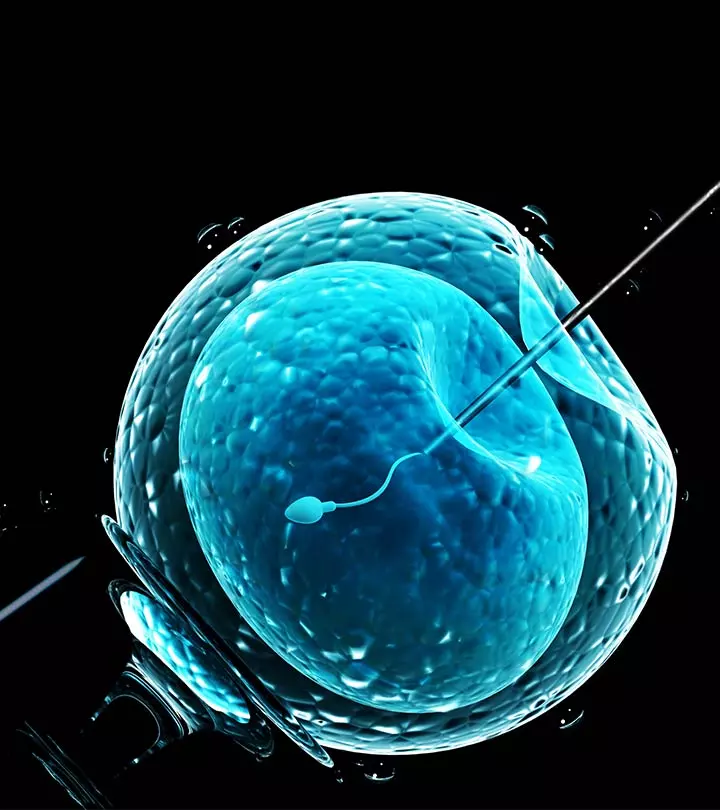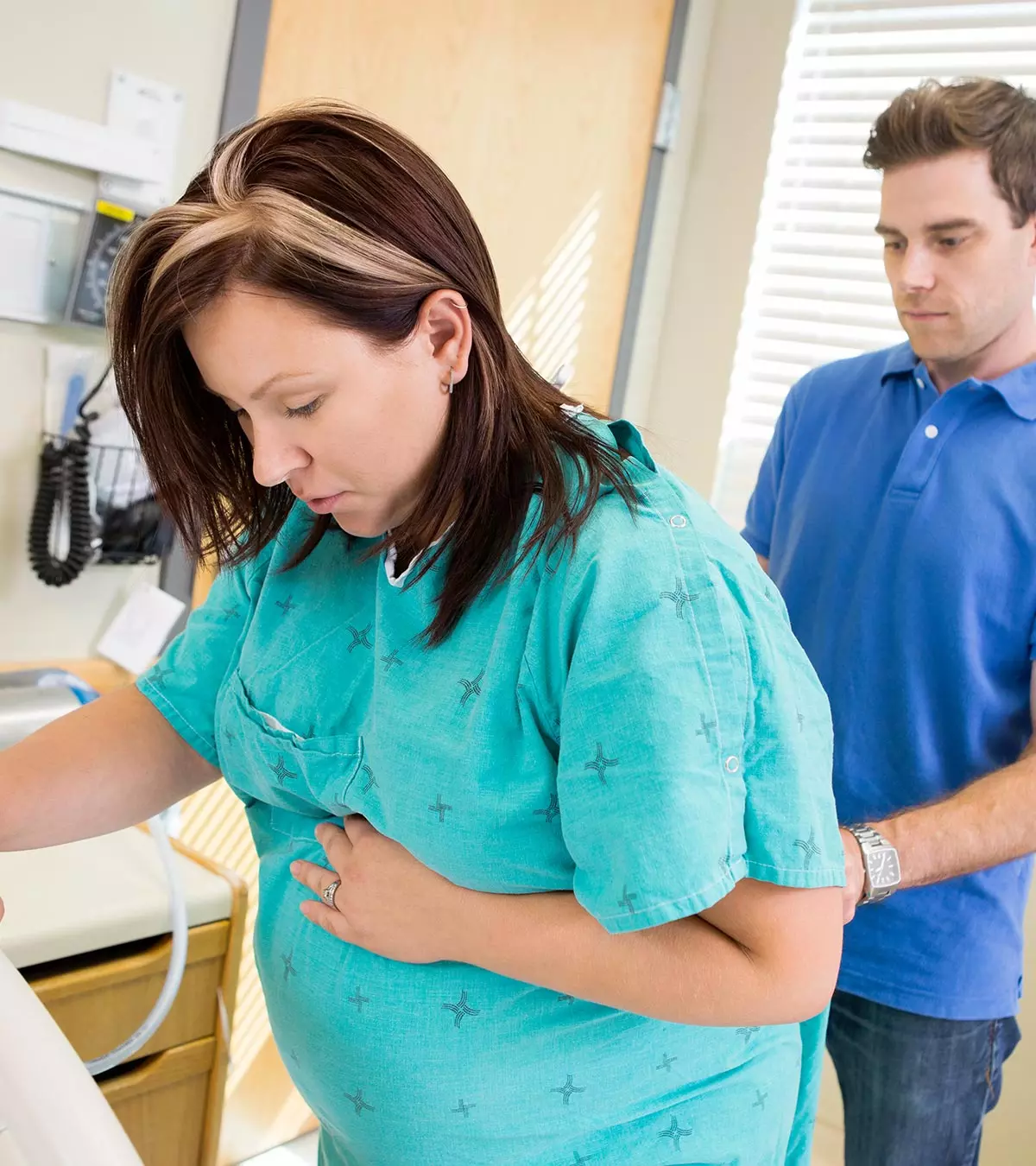

Image: iStock
In vitro fertilization or IVF is an assisted reproductive technology (ART) that helps several couples conceive when natural conception is not possible. This technique causes conception medically, and its success rates are increasing globally.
According to the US Society of Assisted Reproductive Technology (SART), approximately one million babies were born through IVF between 1987 and 2015 in the US alone (1). Globally, over eight million babies have been born via this technology since 1978 (2).
Read on to know more about IVF, when it is used, how it is done, risks involved, side effects, success rates, and the treatment costs.
What Is In Vitro Fertilization?
IVF is a fertility method wherein the egg is fertilized outside the woman’s body and then placed into the uterus. The fertilized egg is then carefully monitored to see if it is developing healthily (2). Although the procedure is becoming common due to the increasing success rates, it is a complex technique.
IVF treatment includes a series of steps and medications, which may differ from one case to another. The basic concept of the procedure, which remains the same in most cases, is explained next.
It starts with medications for releasing mature eggs from the ovaries. Once the ovary releases the egg (or oocyte), it is extracted from the woman’s body and sent to a laboratory for fertilization. Once the resultant embryo is adequately developed, it is transferred into the woman’s uterus.
The procedure can be performed with the egg and sperm of the couple. However, in the case of same-sex couples, single women, and couples who have issues with the egg or sperm, a donor’s egg or sperm may be used.
The donor could be anonymous or a known person, depending on the couple’s preference. Fertility centers also have sperm or egg donation programs that can be utilized in such cases.
When Is In Vitro Fertilization Used?
Both men and women can have issues that could impact their chance of having a baby. Here are some of the causes of infertility, where IVF can be used:
- Age and infertility: With age, the quality of eggs diminishes. In such cases, IVF provides a better chance of conception by letting the couple select good quality eggs or increase the number of eggs fertilized (3).
- Male infertility: Low quality or quantity of sperm could be a cause of infertility. However, ARTs such as IVF and Intracytoplasmic sperm injection (ICSI) could help increase the sperm quality (4).
- Repeated pregnancy loss: Ovulation disorders, premature ovarian failure, and fallopian tube damage are some of the factors that contribute to miscarriage or repeated loss of pregnancy. In such cases, IVF could be an effective technique to improve the chance of pregnancy (5).
- Genetic disorder: When one of the partners has a genetic disorder, and there is a chance of them passing it to the baby, IVF can be used to reduce that risk (5).
- Fibroids and endometriosis: These contribute to female infertility, but advanced IVF treatments could make conception possible.
- Others: Hormonal imbalance and unexplained infertility could be other reasons preventing a couple from having a baby. In such cases too, IVF could be helpful.
IVF, however, is not for everyone. Whether or not it works for you depends on a few screening tests that are done before the procedure.
Preparation Before IVF
When a couple goes to the fertility center or to the hospital to find out more about in vitro fertilization, the doctors start with a consultation. They try to diagnose the cause of infertility, followed by a series of screening tests:
- Ovarian reserve test: This test is for women to assess if there is a decrease in the ovarian reserve, and to determine the nature of eggs. Based on the results, certain fertility medications could be prescribed (6).
- Infections screening: Both the partners are tested for infections and other diseases that could be passed to the baby through IVF.
- Semen analysis: The man needs to get this test done to check the sperm count and other relevant aspects (7).
- Others: Besides the medical tests and screenings, it is essential to maintain a healthy body for in vitro fertilization. Having healthy food, quitting smoking and alcohol, taking prenatal vitamins, and exercising regularly are some of the lifestyle changes that are to be included in the daily routine before you begin the IVF procedure.
How Is In Vitro Fertilization Done?
In vitro fertilization includes several steps and may sometimes take a long time. Every step of the procedure needs to be timed and meticulously done.
- Ovulation induction: This step is also known as ovarian stimulation, wherein fertility drugs or medications are given to the woman to release multiple eggs to improve the chances of fertility. Blood samples are drawn, and ultrasound scans done to monitor ovarian follicle development, for timing the procedure right.
Certain medications such as Letrozole and clomiphene citrate are given orally while some are injected. The others include human chorionic gonadotropin, follicle stimulating hormone, and luteinizing hormone. Medications to prevent premature ovulation can be used as well (8) (5).
- Egg retrieval: A minor surgery is performed to extract the eggs. Doctors give medication for pain relief. Then an ultrasound probe (a thin needle) is inserted through the vagina to retrieve the eggs. The eggs are transferred to a dish and then to an incubator. This step takes around 30 minutes.
Light cramping could be experienced for a day or two after the surgery. The woman is monitored for a few days after the surgery and then discharged.
- Fertilization:The sperm from the partner or donor are obtained via masturbation in a sterile cup, or via other ways (epididymis or testicle). The retrieved sperm is put in a spin cycle for a wash, to find the healthiest sperm of all.
The healthiest sperm and the best eggs are combined in the laboratory during the insemination process or through ICSI or intracytoplasmic sperm injection, where the sperm is injected into the egg (9).
- Embryo transfer: The uterus of a woman is carefully watched via ultrasound before the transfer. The process involves placing a small catheter into the uterine cavity. Then the embryos are placed into the uterus with the help of a transfer catheter. Although the process is painless, some may experience cramping.
The abdominal ultrasound gives the view of the catheter inside the uterus. Once it reaches the right place, the embryos are released (10).
After about ten days, a pregnancy test is done to check if the embryo has been implanted successfully. If hCG hormone is detected, it indicates positive pregnancy.
Since IVF is a complicated procedure with a series of steps, some women might experience certain side effects.
Side Effects Of In Vitro Fertilization
Either the medications or the procedure could be responsible for some side effects (11).
- Mood swings and headache
- Nausea, vomiting, and abdominal pain
- Weight gain
- Shortness of breath
- Mild cramping
- Bloating and constipation
- Breast tenderness
- Light bleeding
In case the side effects do not diminish or worsen with time, consult the doctor to avoid further risks.
Yes, there could be a possibility of risks with this technique. However, they are not so common and not a reason to worry, but being aware of them could be helpful (12) (13).
- Multiple births: Since more than one embryo is placed into the uterus, there is a 20-25% chance of a twin pregnancy. The possibility of multiple births is higher with older women.
- Infection and bleeding: Although the egg retrieval process is minor and simple, there could be risks of infection and bleeding if the surgery is not performed correctly. Although rare, there could be a risk of injury as well.
- Birth defects: These risks are observed in cases where the parents are older.. However these could be detected before transfer of the fertilized by doing ICSI and testing the genetic material.
- Prematurity and low birth weight: This is another rare situation associated with high stimulation IVF. Nevertheless, careful monitoring and proper care help the baby with proper development (14).
- Others: Ectopic pregnancy, congenital anomalies, mental and physical stress could be other risks associated with IVF (15).
Adhering to the doctor’s instructions and careful implementation of the IVF procedure can bring down the chances of risks and improve the chances of success.
What Is The Success Rate Of In Vitro Fertilization?
The rate of success depends on several factors, including the patient’s age, medical history, cause of infertility, initial screening, and more. According to the SART, the success rate of IVF is more with women who are less than 35 years of age (1). The probability of a singleton birth, normal birth weight, and full terms as per the age is:
- Younger than 35: Greater than 20%
- Age between 35 and 37: 17%
- Age between 38 and 40: 11.1%
- Age between 41 and 42: 5.7%
- Age between 43 and 44: 2.3%
- Above 44: 0.6%
Though IVF can be effective in helping you conceive, it comes at a cost. Find out more about the monetary costs you have to incur for this procedure.
What Is The Cost Of IVF Treatment?
The in vitro fertilization cost depends on a lot of factors that include cost per cycle, singleton or multiple births, donor’s fee, medications, consultation, and screening. While some fertility centers consider insurance, some might not.
According to Resolve.org, the average cost of IVF in the US is $23,000. But according to the American Society for Reproductive Medicine, it is $12,400 per cycle. The average cost as per Kaiser Permanente is between $10,000 and $15,000 (16) (17) (18).
Next, we answer some commonly asked questions regarding IVF.
Frequently Answered Questions
1. What if I don’t produce healthy eggs or my husband is sterile?
When one partner is going through infertility issues, IVF works by making use of a donor’s eggs or sperm. The same also applies in the case of same-sex marriage. The fertility centers have donor programs that can assist couples in finding the best suitable donor, and the follow-up steps are done legally.
2. How many embryos should be created or transferred?
The number of embryos that are safe to transfer varies from case to case, based on factors such as age, previous live birth in an IVF cycle, and the number of high-quality embryos that are available for transfer. The doctor will discuss the pros and cons of multiple transfers before any decision is taken (19).
3. Should I try IUI before IVF?
IUI or intrauterine insemination is a procedure that collects the sperm and transfers it into the uterus. In IVF, the eggs and sperm are combined outside the uterus, and then the fertilized egg is placed in the uterus. Talk to your doctor to determine which method suits you the best (20).
4. How should I choose the infertility clinic?
Consider factors such as the background of the clinic, success rates, cost of the treatment, insurance coverage, fertility treatments offered, the technology used, attitude of the staff, and donor programs before choosing a clinic. You can also visit for a consultation before you make a selection.
With more couples facing fertility issues, in-vitro fertilization is gaining momentum. IVF is not only helpful for cases where women experience infertility but also for male infertility, same-sex couples, couples who have experienced repeated miscarriages, or women with conditions such as endometriosis and fibroids, etc. The treatment and process can be emotionally and financially taxing. IVF is also associated with many side effects like any other medical procedure. Discuss all possible side effects and complications with your doctor before deciding to go for the procedure.
Key Pointers
- In vitro fertilization (IVF) is a fertility treatment where the egg is fertilized outside the woman’s body and then implanted into the uterus.
- Before the IVF procedure, doctors attempt to identify the cause of infertility, followed by a series of screening tests.
- The process includes ovulation induction, egg and sperm retrieval, fertilization in the laboratory, and embryo transfer to the uterus.
- Though uncommon, IVF may increase the risk of multiple births, birth abnormalities, premature birth, etc.
References
1. IVF by the Numbers; Penn Medicine (2018)
2. IVF and Fertility in the MENA Region 2019; Colliers International
3. What Is In-Vitro Fertilization?; University of Utah
4. Age and fertility; American Society For Reproductive Medicine
5. Male Infertility; Johns Hopkins Medicine
6. E. L. Stevenson, P. E. Hershberger, and P. A. Bergh; Evidence-Based Care for Couples with Infertility; jognn.org (2015)
7. Testing and interpreting measures of ovarian reserve: a committee opinion; American Society for Reproductive Medicine (2015)
8. J. Cohen et al.; In vitro fertilization: a treatment for male infertility; Fertility And Sterility (1985)
9. Assisted Reproductive Technology; American Society For Reproductive Medicine (2018)
10. A Step-By-Step Look At The IVF Process; Penn Medicine (2016)
11. What to Expect During In Vitro Fertilization; ourbodiesourselves.org (2014)
12. In Vitro Fertilization: Hazards & Challenges; American Institute of Medical Sciences & Education (2015)
13. In Vitro Fertilization (IVF); Obstetrics & Gynecology Medical College of Wisconsin
14. B. Bhagavath, E. Masaba, J. T. Queenan, and W. Vitek; In Vitro Fertilization Process, Risk, and Consent; University of Rochester Medical Center
15. S. Campbell; The advantages and disadvantages of IVF; Create Fertility
16. In Vitro Fertilization: Perinatal Risks and Early Childhood Outcomes; Royal College of Obstetricians & Gynaecologists (2012)
17. Facts; Coalition to Help Families Struggling with Infertility; resolve.org
18. White Paper: Access to Summit; Overview: ASRM Takes Proactive Steps to Address Access to Fertility Care; American Society for Reproductive Medicine (2015)
19. In Vitro Fertilization for Infertility; Kaiser Permanente
20. M. Patil and D. Shah; Maximum number of embryos to be transferred in assisted reproductive technologies cycle: Ethics opinion; Journal of Human Reproductive Sciences (2018)
21. The Difference Between IUI and IVF; Society For Assisted Reproductive Technology
Community Experiences
Join the conversation and become a part of our nurturing community! Share your stories, experiences, and insights to connect with fellow parents.
Read full bio of Dr. Anita Gondy
Read full bio of Rebecca Malachi














